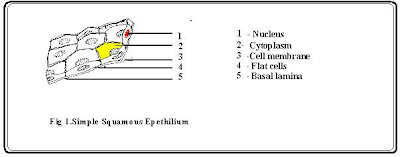EPETHILIAL TISSUE
Epethilial tissue covers the whole surface of the body.It covers body surfaces and lines hollow organs, body cavityies and ducts.It also forms glands
An epethilial tissue consist of cells arranged in continuos sheets, in either single or multiple layers.As cells are closely packed and are held tightly together by many cell junctions, there is little intercellular space between adjacent plasma memberanes.
Epethilial tissue may be divided inti two types :
- Covering and lining epethilium : It forms the outer covering of skin and some internal organs.It also forms the inner lining of blood vessels, ducts and body cavities, and the interior of respiratory tract, digestive tract, urinary tract and reproductive tract. Epithelial tissue that occurs on surfaces on the interior of the body is known as endothelium
- Glandular epethilium : It makes up the secretin portion of the glands such as thyroid gland, adrenal gland and sweat gland.
The covering and lining epethilium tissue is further classified according to two characteristics like the arrangement of cells into layers and the shapes of the cells.
According to arrangement of cells into layers :
SIMPLE EPETHILIUM : Layer of cells that functions in diffussion, osmosis, filteration, secretion, absorption.It may be:
- Simple squamous (pavement) epithelium
Description : Single layer of flat cells, Centrally located nucleus.
Location : Lines heart, Blood vessels,Lymphatic vessels, Air sacs of lungs. Glomerular (Bowman's capsule) of kidney, Inner surface of tympanic membrane( Ear drum),
Functions : Filtration, diffussion ,Osmosis and Secretion into serous memberanes
2. Simple Cuboidal Epithelium
Description : Single layer of cube shaped cells, Centrally located nucleus.
Location : Covers the surface of ovary, Lines anterior surface of capsule of lens of eye, Lines kidney tubules and smaller ducts of many glands, Makes up secretion portion of thyroid gland and duct of pancreas.
Functions : Secretion and Absorption.
3 Simple Columnar Epithelium
Description : One or more layers, Elongated and Column-shaped and Elongated nuclei located near the base of the cells.Goblet cells (unicellular glands) are found between the columnar epithelial cells of the duodenum. They secrete mucus or slime, a lubricating substance which keeps the surface smooth.
Location : Lining of the stomach and intestines, Specialised for sensory reception such as in the nose, ears and the taste buds of the tongue.
Functions : Secretion and Absorption.
4. Ciliated Columnar Epithelium
Description : simple columnar epithelial cells, in addition, they posses fine hair-like outgrowths, cilia on their free surfaces.
Location : Air passages like the nose,Uterus and Fallopian tubes of females
Functions : Capable of rapid, rhythmic, wavelike beatings in a certain direction
STRAITED EPETHILIUM
1. Stratified squamous epithelium.
Description : Several layers of cells cuboidal to columnar shape in deep layers.
Location : Keratinized variety forms superficial layer of skin, nonkeratinized variety lines wet surface such as lining of mouth , eosophagus.
Function : Protection.
2. Straitified cuboidal epethilium
Description : Two or more layers of cells in which the cells in the apical layer is in cube shaped.
Location : Ducts of adult sweat glands and esophageal glands and part of male urethera.
Function : Protection, Limited secretion and Absorption.
3. Straitified columnar epethilium
Description : Several layers of irregularly shaped cells, only the apical layer has columnar cells.
Location : Lines part of Urethra, Large excretory ducts of some glands such as esophagus glands, small areas of anal mucous membrane, and par of the conjunctiva of the eye.
Function : Protection
4. Transitional epethilium
Description : Appearance is variable (transitional), shape of cells in apical layer ranges from sqamous (when stretched ) to cuboidal (when relaxed).
Location : Lines urinary bladder and portions of ureters and urethra.
Function : Permts distension.
GLANDULAR EPETHILIUM
1.Endocrine glands
Description : Secretory products (hormones) diffuse into blood after passing through interstitial fluid.
Location : Pituitary glan at base of brain, Pineal gland in brain, Thyroid and Parathyroid gland near larynx, Adrenal glands superior of kidneys.
Function : Produce hormone that regulate various body activities.
2. Exocrine glands
Description : Secretory products released into ducts.
Location : Sweat, Oil and Earwax glands of the skin, Digestive glands such as salivary glands and pancreas.
Function : Produce substance such as Sweat , Oil earwax , Saliva and Digestive enzymes.







Explain why the genetic code is universal and common to almost all organisms?
ReplyDeleteCommon Descent from a Common Ancestor: predicts universal genetic code.
ReplyDeleteIf you're feeling overwhelmed by your academic load and stuck between multiple commitments, don't worry! Do my online class US is here. It will help you manage your responsibilities more effectively while providing valuable knowledge for your future. The flexibility of online learning allows you to balance everything at your own pace.
ReplyDeleteUnderstanding epithelial tissue can be tricky at first, especially when trying to grasp its different types and functions. I remember struggling with similar topics, and I found that sometimes getting help can make a difference. If you ever find yourself stuck, services like buy assignment UK offer great support for tough subjects. It’s nice to know that there are resources out there to help simplify complex topics.
ReplyDeleteLearning about epithelial tissue can be fascinating, but sometimes assignments can make it challenging to focus. For students seeking help, the best dissertation help UK, like Dissertation Help Services, can make a difference. They provide support for writing and structuring your dissertation, ensuring it meets academic standards. Whether you’re dealing with complex topics like epithelial tissue or any other subject, their assistance helps you stay on track and manage your workload without feeling overwhelmed.
ReplyDelete